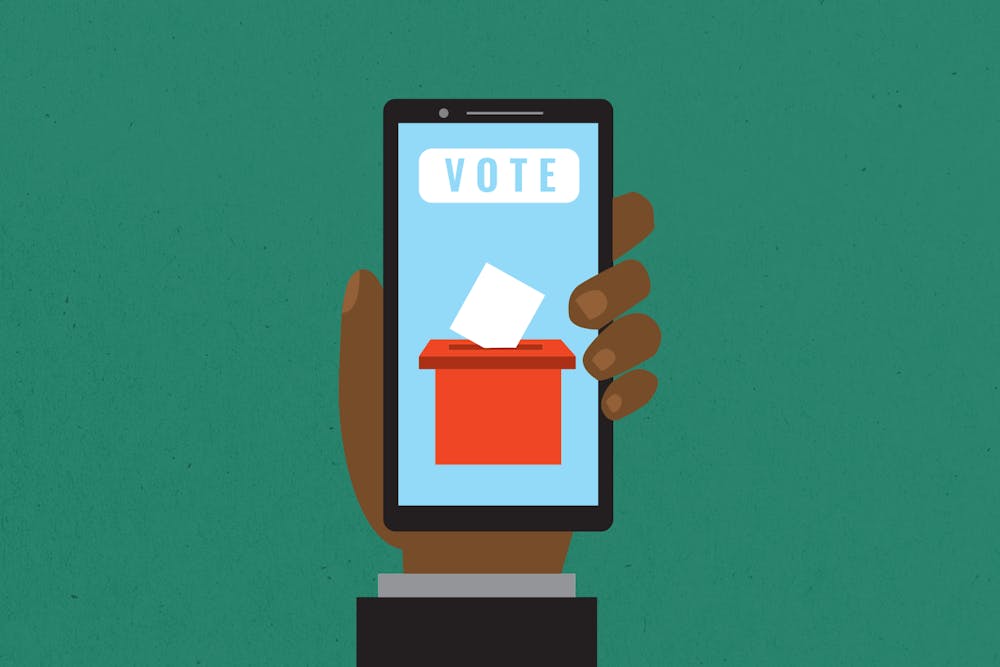Forty-one million members of Generation Z will be voting in the 2024 election, including 8.3 million new eligible voters since the 2022 midterm election, according to Tufts University.
With this influx of new voters, candidates are now allocating large amounts of money into digital advertising to reach Gen Z voters using social media. It was predicted that digital advertising for the 2024 presidential election would increase 156% compared to the 2020 presidential election, making the total spending $3.46 billion, according to a report released by Insider Intelligence predicting the amount of money that will be spent on U.S. political advertising.
Politicians have to start utilizing digital advertising, Michele Lashley, professor of strategic communications, said.
“They can't afford not to do it,” Lashley said. “Young voters are getting the majority of their news, it's not on broadcast television, it's on social media. You have to advertise where your audience already is.”
Aside from reaching younger voters, digital advertising is less expensive than traditional advertising, Lashley said. But, digital advertising still has issues, Lashley said.
“There's so much being thrown at people that the campaign ads are also competing against everything else that is filling up our social media feeds,” Lashley said. “It's not like you can just throw an ad on social media and think that it's going to get attention.”
In addition to the competitiveness of digital advertising, social media algorithms play a large role in what content you see on social media. Junior Lily Nordheimer said she likes how candidates are using social media to connect with young voters.
“Obviously they didn't grow up with it,” Nordheimer said. “This is the best way to reach out to the younger generations who are new to voting, so I think it's really smart.”
Lashley said she thinks candidates using social media allows for them to connect with their electorate on a human level rather than broadcast advertising.
These politician content channels shift the focus of the advertisement to the politician and what work they are currently doing, according to Lashley. This is different from traditional advertising, which can promote the candidate, attack their opponent or contrast between the two. Kamala HQ, a content channel created as a part of Vice President Harris’ campaign includes memes about what is happening in politics, statistics about Harris’ campaign and statements from other politicians who are in favor of Harris.
“Content channels like Kamala HQ give candidates a chance to provide their human side,” Lashley said. “They can get online and do fun things that make them look more human and tell their stories.”
Kamala HQ isn’t the only example of politician content channels. North Carolina state representative Democrat Jeff Jackson has 2.2 million followers on TikTok and creates content describing issues currently taking place in American government and the House of Representatives, including government shutdowns, Supreme Court decisions and most recently Hurricane Helene relief.
Biotech CEO Vivek Ramaswamy, one of the former Republican presidential candidates who currently is supporting the Republican party, has also been utilizing TikTok as a way to reach younger voters. With 694,200 followers on TikTok, Ramaswamy creates content supporting other candidates, branding himself and talking about his personal life.
“We’re in this to reach young people, to energize young people,” Ramaswamy said in his first TikTok announcing his campaign for the 2024 presidential election. “You can’t play in the game and then not play in the game.”
Aside from the humanity that social media can provide for candidates, Lashley said social media and digital advertising can also be used for spreading unintentional branding.
“Whether it's a scandal or leaked video or audio, or if a candidate says something, maybe they shouldn't have,” Lashley said. “Then those can be taken out of context, and they can become viral.”
Junior Kayla Berkoff said she thinks social media is a better platform for campaign advertising instead of broadcast advertising.
“Those commercials where they just try to take jabs at each other is so pointless and so annoying to have to rewatch them over and over and over,” Berkoff said. “Social media is so big now especially with Gen Z. This is their first election and that’s how they can get a hold of them and get information out.”
Despite the amount of money the Harris and Trump campaigns are spending on digital advertising for social media platforms, Lashley said she thinks traditional advertising will never go away completely.
“As long as there are potential voters who are using traditional media, like broadcast television, newspapers, talk radio, I think that campaigns will see a need to continue putting money toward ads on those platforms,” Lashley said.
However, Lashley said she does see a future election where the same amount of money is being spent on digital advertising than traditional advertising.
“I think that we're going to be moving more and more to digital formats, but I don't think we're there yet, maybe in three cycles,” Lashley said. “I think that maybe it equals out where there's an equal amount of resources being put toward traditional advertising with traditional media, and equal amount being put into digital media.”


